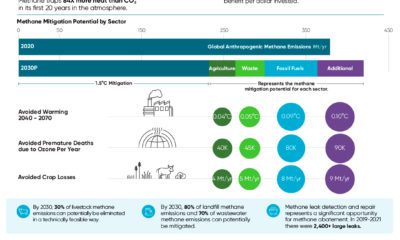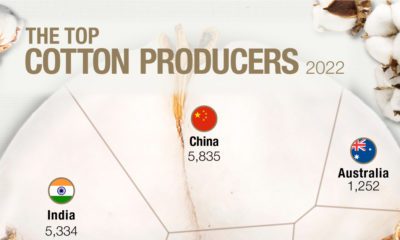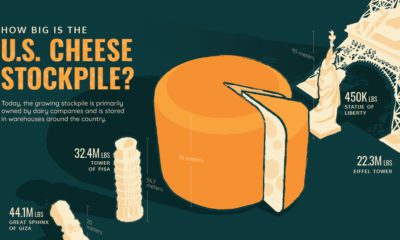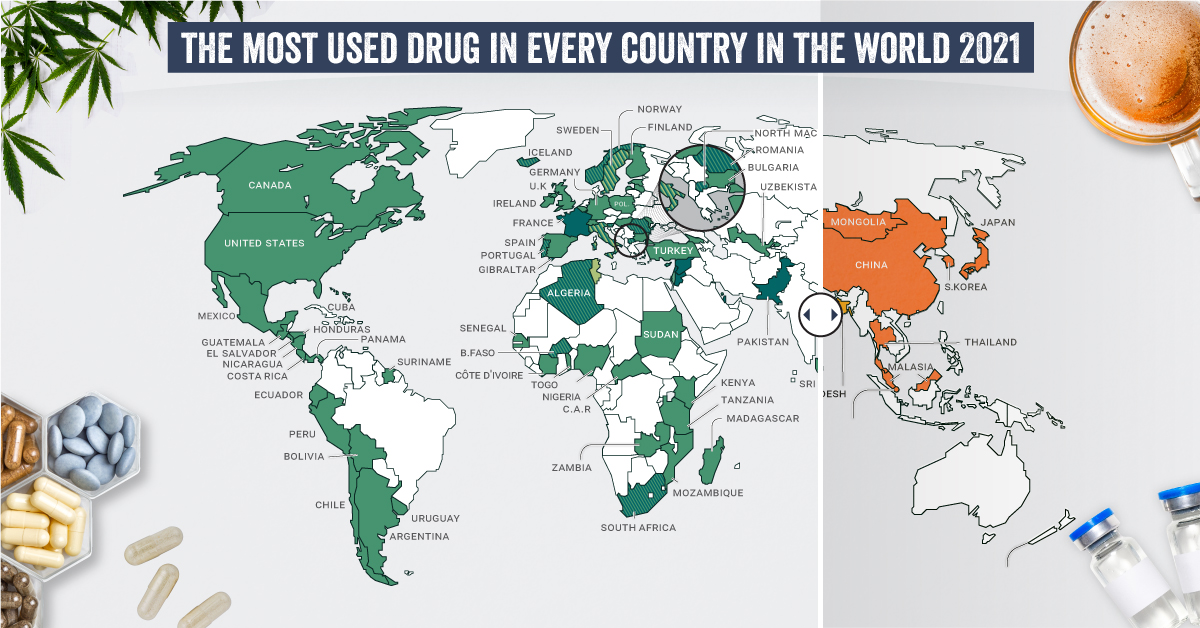As cannabis breaks into the mainstream, the complex web of regulations surrounding the plant may well be what compels the industry to think outside the box. Today’s infographic from Valens GroWorks highlights some of the most anticipated areas of technology-based disruption in “cannabiz” – the business behind cannabis.
Potential Industry Game-changers
As the cannabis industry grows, the business behind it must grow as well – and to get an edge, industry players are investing in new technologies and innovative practices that could be industry game-changers. Here are some of the most disruptive moves happening that could shape the future of cannabis:
Agricultural Technology
As consumers become more discerning, they’ve come to demand premium quality cannabis. That’s why many indoor growers are exploring various means to improve the productivity of cannabis plants.
Cloud-controlled lights Using cloud-based IoT technology, cultivators can remotely adjust the colors and cycles of growing lights that cannabis plants are exposed to in their operations. Such precise control ensures consistency in plant quality. Tissue culture Essentially, tissue culture is the multiplication of a single cannabis tissue into hundreds of identical ones. While this method is impressive, it’s incredibly tricky to get right at scale.
Biotech breeding is another upcoming trend to watch out for. Just like the ubiquitous GMO foods you can find in a grocery store, the genetic manipulation of cannabis plants to strengthen specific effects could take the industry by storm.
Novel Delivery
Millions of patients in North America rely on medical cannabis, which will only intensify as states continue to legalize its use. For the longest time, prescribed cannabis has relied on smoking – but extraction technology is introducing new delivery methods.
Vaporizer Pens These pocket-sized pens can deliver a controlled cannabis dose, with lower chances of including dangerous chemicals. The latest models include Bluetooth capabilities and smartphone apps to customize vape temperatures, among other features. Oils and Tinctures Cannabis concentrates, packaged into capsules or as liquid, can be used in vape pens or ingested directly. They also provide a small, controlled cannabis dose, and act fast in a patient’s system.
Consumer Products
Recreational consumers won’t be left behind. This growing segment is enjoying cannabis-based products in a myriad of ways, made possible by new extraction technologies.
Nano-technology Water soluble oils demonstrate their potent effects quickly through the bloodstream, instead of relying on the slow-acting respiratory or digestive systems. Topicals With a wide range of skincare products in the market, these cannabis-infused lotions can applied to the skin’s surface, where they are absorbed for a relaxing effect.
Cashless Payments
Despite the increasing legality of “cannabiz”, many businesses and their customers prefer to deal with cash. Financial institutions are also wary of investing in cannabis, as it’s still perceived as risky in certain circles. To that end, fintech has stepped up to the plate. Secure and automated transactions can be made and processed via the blockchain, potentially creating an anonymous and convenient way for consumers and companies to transact.
Data and Analytics
Cannabis is finally coming out of hiding, but records around point-of-sale transactions are still lacking. Providing context for such data to give it meaning is difficult, but lucrative. Leveraging big data to track the cannabis supply chain has secondary advantages of easing the regulatory process, and putting customer demand into perspective. What’s more, digital transaction data on these consumers also offers future opportunities for businesses to address their needs. As the cannabis space steadily progresses, cannabis companies that respond and adapt to these broad trends of tech innovation will be poised for success. – Michael Garbuz, CannRoyalty Corporate Strategist on Humans have a storied and complicated relationship with drugs. Defined as chemical substances that cause a change in our physiology or psychology, many drugs are taken medicinally or accepted culturally, like caffeine, nicotine, and alcohol. But many drugs—including medicines and non-medicinal substances taken as drugs—are taken recreationally and can be abused. Each country and people have their own relationship to drugs, with some embracing the use of specific substances while others shun them outright. What are the most common drugs that are considered generally illicit in different parts of the world? Today’s graphics use data from the UN’s World Drug Report 2021 to highlight the most prevalent drug used in each country.
What Types of Common Drugs Are Tracked?
The World Drug Report looks explicitly at the supply and demand of the international illegal drug market, not including commonly legal substances like caffeine and alcohol. Drugs are grouped by class and type, with six main types of drugs found as the most prevalent drugs worldwide.
Cannabis*: Drugs derived from cannabis, including hemp. This category includes marijuana (dried flowers), hashish (resin), and other for various other parts of the plant or derived oils. Cocaine: Drugs derived from the leaves of coca plants. Labeled as either cocaine salts for powder form or crack for cocaine processed with baking soda and water into rock form. Opioids: Includes opiates which are derived directly from the opium poppy plant, including morphine, codeine, and heroin, as well as synthetic alkaloids. Amphetamine-type Stimulants (ATS): Amphetamine and drugs derived from amphetamine, including meth (also known as speed), MDMA, and ecstasy. Sedatives and Tranquilizers: Includes other drugs whose main purpose is to reduce energy, excitement, or anxiety, as well as drugs used primarily to initiate or help with sleep (also called hypnotics). Solvents and Inhalants: Gases or chemicals that can cause intoxication but are not intended to be drugs, including fuels, glues, and other industrial substances.
The report also tracked the prevalence of hallucinogens—psychoactive drugs which strongly affect the mind and cause a “trip”—but no hallucinogens ranked as the most prevalent drug in any one country. *Editor’s note: Recreational cannabis is legal in five countries, and some non-federal jurisdictions (i.e. states). However, in the context of this report, it was included because it is still widely illicit in most countries globally.
The Most Prevalent Drug in Each Country
According to the report, 275 million people used drugs worldwide in 2020. Between the ages of 15–64, around 5.5% of the global population used drugs at least once. Many countries grouped different types of the same drug class together, and a few like Saudi Arabia and North Macedonia had multiple different drug types listed as the most prevalent. But across the board, cannabis was the most commonly prevalent drug used in 107 listed countries and territories: How prevalent is cannabis worldwide? 72 locations or more than two-thirds of those reporting listed cannabis as the most prevalent drug. Unsurprisingly these include countries that have legalized recreational cannabis: Canada, Georgia, Mexico, South Africa, and Uruguay.
How Common Are Opioids and Other Drugs?
Though the global prevalence of cannabis is unsurprising, especially as it becomes legalized and accepted in more countries, other drugs also have strong footholds. Opioids (14 locations) were the most prevalent drugs in the Middle-East, South and Central Asia, including in India and Iran. Notably, Afghanistan is the world’s largest producer of opium, supplying more than 90% of illicit heroin globally. Amphetamine-type drugs (9 locations) were the third-most common drugs overall, mainly in East Asia. Methamphetamine was the reported most prevalent drug in China, South Korea, and Japan, while amphetamine was only the most common drug in Bangladesh. However, it’s important to note that illicit drug usage is tough to track. Asian countries where cannabis is less frequently found (or reported) might understate its usage. At the same time, the opioid epidemic in the U.S. and Canada reflects high opioid usage in the West. As some drugs become more widespread and others face a renewed “war,” the landscape is certain to shift over the next few years.












